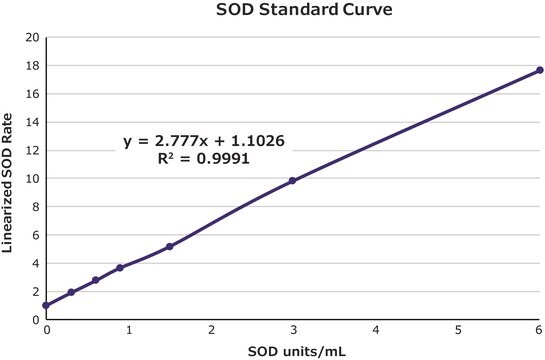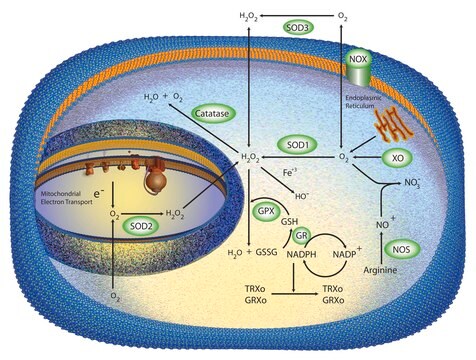Descrizione generale
A sensitive spectrophotometric assay (540 nm) for the measurement of catalase (CAT) activity in plasma, serum, erythrocyte lysates, tissue homogenates, and cell lysates. Assay range: 0.25-4 nmol/min/ml. Contains sufficient reagents for 96 tests.
Componenti
Assay Buffer, Sample Buffer, Formaldehyde Standard, Catalase, Potassium Hydroxide, Methanol, Hydrogen Peroxide, Purpald (Chromogen), Potassium Periodate, 96 Well Plate, Plate Cover
Attenzione
Toxicity: Multiple Toxicity Values, refer to MSDS (O)
Nota sulla preparazione
• 1X Assay Buffer: Dilute 2 ml 10X Assay Buffer concentrate with 18 ml of HPLC-grade water. This final 1X Assay Buffer (100 mM potassium phosphate, pH 7.0) should be used in the assay. When stored at 4°C, this diluted 1X Assay Buffer is stable for at least two months.• 1X Sample Buffer: Dilute 5 ml 10X Sample Buffer concentrate with 45 ml of HPLC-grade water. This final 1X Sample Buffer (25 mM potassium phosphate, pH 7.5, containing 1 mM EDTA and 0.1% BSA) should be used to dilute the formaldehyde standards, Catalase (Control), and samples prior to assaying. When stored at 4°C, this diluted 1X Sample Buffer is stable for at least two months.• Formaldehyde Standard: This vial contains 4.25 M formaldehyde. The reagent is ready to use as supplied.• Catalase (Control): This vial contains a lyophilized powder of bovine liver Catalase (CAT) and is used as a positive control. Reconstitute the CAT by adding 2 ml 1X Sample Buffer to the vial and vortex well. Take 100 µl of the reconstituted enzyme and dilute with 1.9 ml 1X Sample Buffer. A 20 µl aliquot of this diluted enzyme per well causes an absorbance of ~0.29 after subtracting the background absorbance. The diluted enzyme is stable for 30 min. The reconstituted CAT is stable for one month at -20°C.• Potassium Hydroxide: The vial contains potassium hydroxide (KOH) pellets. Place the vial on ice, add 4 ml cold HPLC-grade water, and vortex to yield a 10 M solution. [CAUTION: Heat is generated when potassium hydroxide pellets are dissolved in water. The KOH solution is stable for at least three months if stored at 4°C.]• Hydrogen Peroxide: This vial contains an 8.82 M solution of hydrogen peroxide. Dilute 40 µl Hydrogen Peroxide with 9.96 ml HPLC-grade water. The dilute Hydrogen Peroxide solution is stable for 2 h.• Purpald (Chromogen): This vial contains a solution of 4-amino-3-hydrazino-5-mercapto-1,2,4-triazole (Purpald) in 0.5 M hydrochloric acid. The reagent is ready to use as supplied.• Potassium Periodate: This vial contains a solution of potassium periodate in 0.5 M potassium hydroxide. The reagent is ready to use as supplied.
Note: Overheating can inactivate catalase. The enzyme should be kept cold during sample preparation and assaying. In general, catalase is very unstable at high dilution. It is recommended to store samples concentrated and assay within 30 min after dilution.A. Tissue Homogenates1. Prior to dissection, either perfuse tissue or rinse tissue with a phosphate buffered saline (PBS) solution, pH 7.4, to remove any red blood cells and clots.2. Homogenize the tissue on ice in 5-10 ml cold buffer (i.e., 50 mM potassium phosphate, pH 7.0, containing 1 mM EDTA) per gram tissue.3. Centrifuge at 10,000 x g for 15 min at 4°C.4. Remove the supernatant for assay and store on ice. If not assaying on the same day, freeze the sample at -80°C. The sample will be stable for at least one month.B. Cell Lysates1. Collect cells by centrifugation (i.e., 1000-2000 x g for 10 min at 4°C). For adherent cells, do not harvest using proteolytic enzymes; rather use a rubber policeman.2. Homogenize or sonicate the cell pellet on ice in 1-2 ml cold buffer (i.e., 50 mM potassium phosphate, pH 7.0, containing 1 mM EDTA).3. Centrifuge at 10,000 x g for 15 min at 4°C.4. Remove the supernatant for assay and store on ice. If not assaying on the same day, freeze the sample at -80°C. The sample will be stable for at least one month.C. Plasma and Erythrocyte Lysates1. Collect blood using an anticoagulant such as heparin, citrate, or EDTA.2. Centrifuge the blood at 700-1000 x g for 10 min at 4°C. Pipet off the top yellow plasma layer without disturbing the white buffy layer. Store plasma on ice until assaying or freeze at -80°C. The plasma sample will be stable for at least one month.3. Remove the white buffy layer (leukocytes) and discard.4. Lyse the erythrocytes (red blood cells) in 4 times the packed volume with ice-cold HPLC-grade water.5. Centrifuge at 10,000 x g for 15 min at 4°C.6. Collect the supernatant (erythrocyte lysate) for assaying and store on ice. If not assaying the same day, freeze at -80°C. The sample will be stable for at least one month.D. Serum1. Collect blood without using an anticoagulant such as heparin, citrate, or EDTA. Allow blood to clot for 30 min at 25°C.2. Centrifuge the blood at 2000 x g for 15 min at 4°C. Pipet off the top yellow serum layer without disturbing the white buffy layer. Store serum on ice. If not assaying the same day, freeze at -80°C. The sample will be stable for at least one month.
Stoccaggio e stabilità
Upon arrival store the entire contents of the kit at 4°C.
Risultati analitici
Calculating the Resultsa. Calculate the average absorbances of each standard and sample.b. Subtract the average absorbance of standard A from itself and all other standards and samples.c. Plot the corrected absorbance of standards (from step 2 above) as a function of final formaldehyde concentration (M) from Table 1. See Figure 1 (below) for a typical standard curve.<div class="Bio_doc_image">
Figure 2: Typical Formaldehyde Standard Curve.
</div>d. Calculate the formaldehyde concentration of the samples using the equation obtained from the linear regression of the standard curve substituting corrected absorbance values for each sample.<div class="Bio_doc_image">
Figure 3: Formaldehyde Concentration Equation</div>
e. Calculate the catalase activity of the sample using the following equation. One unit is defined as the amount of enzyme that will cause the formation of 1.0 nmol formaldehyde per min at 25°C.<div class="Bio_doc_image">Figure 4: Activity Equation</div>
Altre note
Due to the nature of the Hazardous Materials in this shipment, additional shipping charges may be applied to your order. Certain sizes may be exempt from the additional hazardous materials shipping charges. Please contact your local sales office for more information regarding these charges.
Wheeler, C.R., et al. 1990. Anal. Biochem.184, 193;
Johansson, L.H., et al. 1988. Anal. Biochem.174, 331.
Note legali
CALBIOCHEM is a registered trademark of Merck KGaA, Darmstadt, Germany













